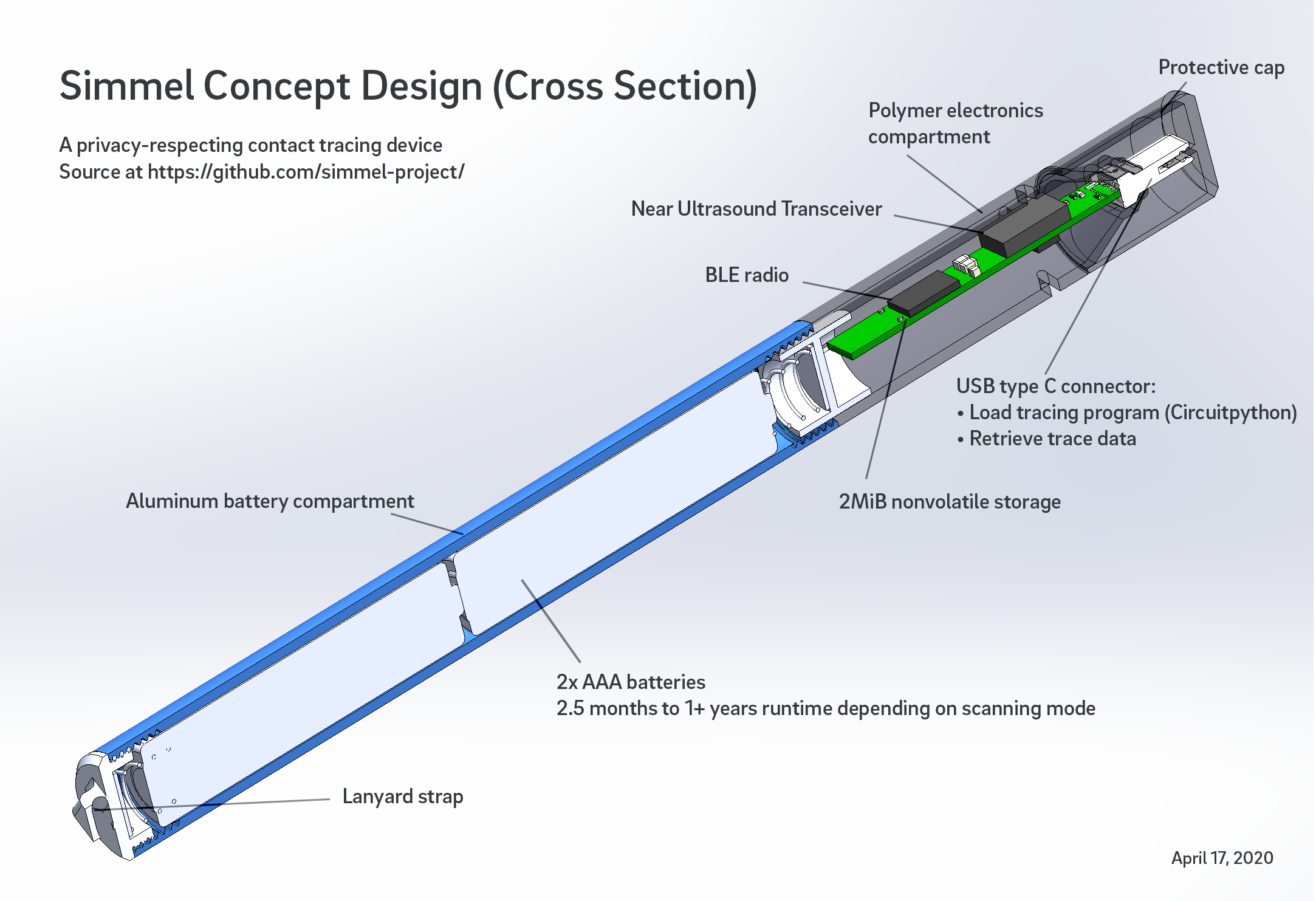Simmel
A wearable contact tracing beacon/scanner
Simmel is a platform that enables COVID-19 contact tracing while preserving user privacy. It is a wearable hardware beacon and scanner which can broadcast and record randomized user IDs. Contacts are stored within the wearable device, so you retain full control of your trace history until you choose to share it.
The Simmel design is open source, so you are empowered to audit the code. Furthermore, once the pandemic is over, you are able to recycle, re-use, or securely destroy the device, thanks to the availability of hardware and firmware design source.
The contact tracing algorithm is programmed using CircuitPython, to facilitate ease of code audit and community participation. The Simmel project does not endorse a specific contact tracing platform, but it is inherently not compatible with contact tracing proposals that rely on the constant upload of data to the cloud.
- The project's own website: https://simmel.betrusted.io
Why does this actually matter to end users?
The SARS-CoV2 pandemic has triggered many different government measures across the world, including unprecedented lock-downs of various degrees of many millions of people. These measures buy time to get ourselves better organised. Because of the immense effects on societies, economies and individuals, such measures can only be temporary in nature, after which societies will have to reboot into a new operational mode as long as there are no effective vaccins.
In such situations of societal crisis, a large array of technologies will be proposed as immediate ad hoc interventions. There is after all significant pressure to just do something, while there is limited oversight whether these technologies would actually help. At the same time, impact on society can be high - when moving fast, things could go horribly wrong too. Move fast, break things, may hold for companies but not for whole societies.
We also need to recognise the significant reserve from the side of citizens that such a situation will somehow be abused. We have seen such a similar fallout after the 9/11 attacks. An old political paradigm dating back to Machiavelli is after all: "Never waste the opportunity offered by a good crisis.". The same holds for cybercrime: new crises will eventually happen, and the opportunistic ability to improvise is also present in those meaning less well. Organisations and individuals in panic mode tend to not make properly weighted decisions, which can result in serious cybersecurity risks but also the disruption of democratic order.
One of the solutions that has emerged - and provoked a lot of discussion - is "contact tracing". Contact tracing means that you use close distance sensing as an approximation of physical proximity, and thus potential risk of infection. There are a number of ways by which this can be done, and most people think of so called "corona apps". But what if the privacy offered by a mobile phone application are not good enough? What if you have an older type of phone incompatible with the features required? What if you do not even have a phone?
Simmel is a small portable contact scanning device, that is crafted specifically to serve this use case. It can do the same thing or more than a phone can do, but in a much more controlled way. It is open hardware, so one can transparently tweak every aspect of the device from top to bottom - in hardware, in firmware and in software. This meaning that (unlike for instance with third party mobile phones) you do not need permission from a platform provider or operator to tweak any features to satisfy the highest security and privacy criteria.
The Simmel project does not endorse any specific contact tracing design, and its designs are free to be used by any initiative. By purpose it is not compatible with proposed technologies that rely on the constant upload of data to the cloud. The owner of the device should always be in control, because trustworthiness is critical to large scale adoption. Simmel is designed for citizens and for science, not for anything else.
This project was funded through the NGI0 Discovery Fund, a fund established by NLnet with financial support from the European Commission's Next Generation Internet programme, under the aegis of DG Communications Networks, Content and Technology under grant agreement No 825322.


